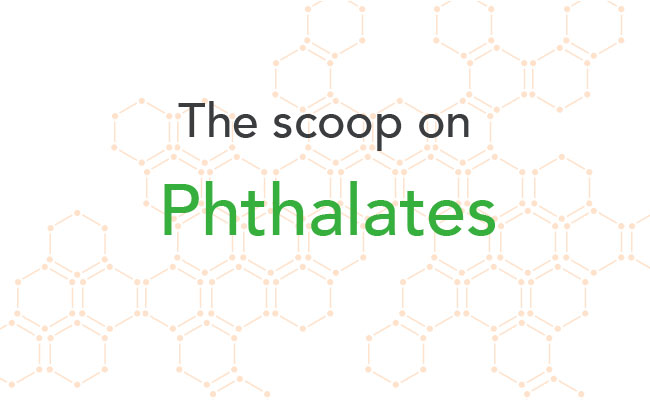What are Phthalates: Chemical Free Living

Toxic Chemical Glossary:
What are Phthalates: Chemical Free Living
What are phthalates?
Phthalates are commonly used in fragranced products like skin moisturizers, soaps, shampoos, hair sprays, and perfumes to help the scent linger longer. Phthalates are a ubiquitous class of chemicals used in softeners, solvents, fragrances, plasticizers, and PVC or polyvinyl chloride products [2]. They’re used to make plastics more flexible and less prone to breakage [3].
What products are phthalates in?
Phthalates are regularly found in fragranced cosmetic & personal care products and nail polish in the United States. They’re currently found in PVC children’s toys, backpacks, food packaging products like cling wrap, medical devices, building materials such as water pipes, vinyl flooring, adhesives, inks, dyes, mosquito repellents and other personal care products [2]. They are also used as an ingredient in nail polish [1] [2] [3].
How to tell if a product has phthalates
Phthalates are typically not listed on ingredient labels. However products that contain “fragrance” on the label are likely to contain phthalates [1]. The one word “fragrance” can include more than 100 different chemicals including phthalates. The reason is that manufacturers are not required to disclose the various chemicals that make up a fragrance. This is because fragrances are considered to be “trade secrets“.
Risks associated with phthalates
- Cancer – According to The National Toxicology Program, phthalates are “reasonably anticipated to be a human carcinogen”.
- Negatively impacts human reproduction and development
- Negatively impacts normal human development
- Newborn males exposed to high levels of DIP through the use of medical feeding tubes or other medical devices may be at risk of abnormal development of the male reproductive system according to the National Institute of Environmental Health Sciences.
- Birth defects
- Respiratory problems
- Behavioral problems in children
- Premature birth
- Decreased sperm counts and damaged sperm [2] [3]
How to avoid phthalates
Avoid phthalates by reading ingredient labels and avoiding any listing “fragrance” on the label [2]. Avoid products that contain DEHP, DBP, BBP, DINP, DIDP, and DnOP. Phthalate-free alternatives include citrates, sebacates, adipates, and phosphates [4]. Also avoid products that contain DBP and plastics with recycling codes 3, 6, & 7.
References:
[1] Campaign for Safe Cosmetics (2016). Phthalates. Available online: http://www.safecosmetics.org/get-the-facts/chemicals-of-concern/phthalates/ December 7, 2016.
[2] Healthy Child Healthy World (2016). Avoid Phthalates: Find Phthalate-Free Products Instead! Available online: http://www.healthychild.org/easy-steps/avoid-phthalates-find-phthalate-free-products-instead%E2%80%A8%E2%80%A8/ December 7, 2016.
[3] CDC (2015). National Biomonitoring Program. Available online: https://www.cdc.gov/biomonitoring/phthalates_factsheet.html December 7, 2016.
[4] Lowell Center for Sustainable Production (2011). Phthalates and Their Alternatives: Health and Environmental Concerns. Available online: http://www.sustainableproduction.org/downloads/PhthalateAlternatives-January2011.pdf December 7, 2016.
